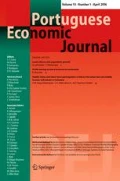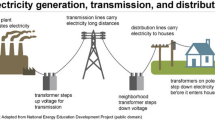Abstract
We study incentives to vertically integrate in an industry with vertically differentiated downstream firms. Vertical integration by one of the firms increases production costs for the rival. Increased production costs negatively affects quality investment both by the integrated firm and the unintegrated rival. Quality investment by both firms decreases under any (vertical integration) scenario. The decrease in quality invesment by both firms softens competition among downstream firms. By integrating first, a firm always produces the high quality good and earns higher profits. A fully integrated industry, with increased product differentiation, is observed in equilibrium. Due to increase in firm profits, social welfare under this structure is greater than under no integration.




Similar content being viewed by others
Notes
OECD 2007, Policy Roundtable on Vertical Mergers, http://www.oecd.org/dataoecd/25/49/39891031.pdf.
This results does not hold when firms merge simultaneously in the first stage. The strategic motive of raising rivals’ costs, which is the focus of most papers, is lost in simultaneous vertical mergers.
Without competing with the remaining upstream firm.
In his model, there are several firms that supply the input. However, only two of them invest in R&D to obtain new technology.
We would like to thank one of the referees for pointing this out.
The quality investment structure in our model is the same as in Motta (1993).
See Shaked and Sutton (1983).
One can formulate the bidding at this stage in several ways. One can use the structure in OSS, which we use. OSS then study the robustness of their results with two different formulations. In one, upstream firms bid, and in the other, downstream firms bid for the two upstream firms. Their main results do not change. Only bids and distribution of profits are different in the first case.
Given the symmetry of the upstream firms, we denote the integrated firm, between D i and U i , as F i .
The advantage of price competition is that it isolates the problem of the strategic value of vertical integration for the integrating firm. For a detailed discussion see OSS.
The incentives to foreclose potential entrants using exclusive contracts has been studied by Aghion and Bolton (1987) and Rasmusen et al. (1991). More recently, Chen and Riordan (2007) analyze the incentives of an integrated firm to foreclose an un-integrated (equally, or more efficient) upstream rival signing an exclusive contract.
The evidence of foreclosure in empirical studies is inconclusive (see Lafontaine and Slade 2007 and Cooper et al. 2005, for an extensive review of this literature). Martin et al. (2001) find evidence of foreclosure in an experimental market. In their design, the vertically integrated firm forecloses its downstream rival in 73% of the cases, with the unintegrated firm profits being only 4% of the industry profits.
This is along the lines of the argument made by the OECD. Vertical integration can produce an increase in market power due to lowered quality investment.
We maintain the notation followed by OSS.
There is a symmetrical equilibrium with firm D 1 (D 2) producing low (high) quality.
Using the same reasoning as in the FI 1 case.
Note that the subsequent offer is also decreasing in the high quality level.
High quality firm takes advantage of the lessening competiton: low quality falls from \(s_{2}^{NI}=0.090223\bar{\theta}^{2}\) to \(s_{2}^{FI_{H}}=0.039411 \bar{\theta}^{2}\).
Note that under simultaneous integration, only profit redistribution takes place with total welfare remaining unchanged.
This result is obtained in our model only if the firms integrate simultaneously. OSS only consider sequential integration. Allowing for simultaneous integration in their model, one obtains a totally integrated industry (as in our case).
Profits before making the integration bid.
References
Aghion P, Bolton P (1987) Contracts as a barrier to entry. Am Econ Rev 77:338–401
Avenel E, Barlet C (2000) Vertical foreclosure, technological choice, and entry on the intermediate market. J Econ Manage Strategy 9:211–230
Banerjee S, Lin P (2003) Downstream R&D, raising rivals costs and input price contracts. Int J Ind Organ 21:79–96
Brocas I (2003) Vertical integration and incentives to innovate. Int J Ind Organ 21:457–488
Chen Y (2001) On vertical mergers and their competitive effects. RAND J Econ 32:667–685
Chen Y, Riordan M (2007) Vertical integration, exclusive dealing, and ex post cartelization. RAND J Econ 38:1–21
Choi JP, Yi S (2000) Vertical foreclosure with the choice of input specifications. RAND J Econ 31:717–743
Cooper J, Froeb L, O’Brien D, Vita M (2005) Vertical antitrust policy as a problem of inference. Int J Ind Organ 23:639–664
Economides N (1998) The incentive for non-price discrimination by an input monopolist. Int J Ind Organ 16:271–284
Foros O (2004) Strategic investments with spillovers, vertical integration and foreclosure in the broadband access market. Int J Ind Organ 22:1–24
Hart O, Tirole J (1990) Vertical integration and market foreclosure. Brookings Pap Econ Act Microecon 1990:205–276
Lafontaine F, Slade M (2007) Vertical integration and firm boundaries: the evidence. J Econ Lit 45:629–685
Martin S, Normann H, Snyder C (2001) Vertical foreclosure in experimental markets. RAND J Econ 32:466–496
Motta M (1993) Endogenous quality choice: price vs. quantity competition. J Ind Econ 2:113–132
OECD (2007) Policy roundtable on vertical mergers. http://www.oecd.org/dataoecd/25/49/39891031.pdf
Ordover JA, Saloner G, Salop SC (1990) Equilibrium vertical foreclosure. Am Econ Rev 80:127–142
Ordover J, Salonerm G, Salop S (1992) Equilibrium vertical foreclosure: reply. Am Econ Rev 82:698–703
Rasmusen E, Ramseyer J, Wiley J (1991) Naked exclusion. Am Econ Rev 81:1137–1145
Reiffen D (1992) Equilibrium vertical foreclosure: comment. Am Econ Rev 82:694–697
Salinger M (1988) Vertical mergers and market foreclosure. Q J Econ 103:345–356
Salop S, Scheffman D (1983) Recent advances in the theory of industrial structure. raising rivals’ costs. Am Econ Rev: Pap Proc 73:267–271
Salop S, Scheffman D (1987) Cost-raising strategies. J Ind Econ 36:19–34
Shaked A, Sutton J (1983) Natural oligopolies. Econometrica 51:1469–1483
Sibley D, Weisman D (1998) Raising rivals’ costs: the entry of an upstream monopolist into downstream markets. Inf Econ Policy 10:451–470
Stefanadis C (1997) Downstream vertical foreclosure and upstream innovation. J Ind Econ 45:445–456
Vickers J (1995) Competition and regulation in vertically related markets. Rev Econ Stud 62:1–17
Acknowledgements
Hernan and Kujal acknowledge support from grant 2009/00055/001 from the Spanish Ministry of Education. Kujal acknowledges support from the Instituto Universitario de Economía, Consolider-Ingenio 2010 and the Comunidad de Madrid (grant Excelecon).
Author information
Authors and Affiliations
Corresponding author
About this article
Cite this article
Hernán González, R., Kujal, P. Vertical integration, market foreclosure and quality investment. Port Econ J 11, 1–20 (2012). https://doi.org/10.1007/s10258-011-0074-z
Received:
Accepted:
Published:
Issue Date:
DOI: https://doi.org/10.1007/s10258-011-0074-z




